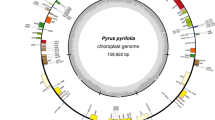Abstract
Wild soybeans collected in Japan were surveyed for RFLPs of chloroplast DNA. Three haplotypes were detected in RFLPs with a cpDNA clone which contains a LSC region adjacent to the left member of IR. Most of the plants tested possessed haplotype III, and a few plants, collected mostly in southern Japan, had haplotype II. Haplotype I, which is the predominant form in modern cultivars, was detected at six sites from four widely separated regions. Our results indicate that haplotype III is predominant in wild soybean of Japan. Some of the plants having haplotype I were phenotypically intermediate between wild and cultivated soybeans, while the others possessed a seed morphology and plant architecture typical of ordinary wild soybean. The plants having haplotype I appear to be either derivatives of hybridization between wild and cultivated soybeans or relics of a direct progenitor of soybean cultivars with the haplotype I chloroplast genome.
Similar content being viewed by others
Literature Cited
Beebe, S., O. Ch. Toro, A. V. Gonzàlez, M. I. Chacòn, and D. G. Debouck. 1997. Wild-weed-crop complexes of common bean (Phaseolus vulgaris L., Fabaceae) in the Andes of Peru and Colombia, and their implications for conservation and breeding. Genetic Resources and Crop Evolution 44:73–91.
Broich, S., and R. G. Palmer. 1980. A cluster analysis of wild and domesticated soybean phenotypes. Euphytica 29:23–32.
Close, P. S., R. C. Shoemaker, and P. Keim. 1989. Distribution of restriction site polymorphism within the chloroplast genome of the genusGlycine sub-genusSoja. Theoretical and Applied Genetics 77: 768–776.
de Wet, J. M. J., and J. R. Harlan. 1975. Weeds and domesticates: evolution in the man–made habitat. Economic Botany 29:99–107.
Doyle, J. J., and J. L. Doyle. 1990. Isolation of plant DNA from fresh tissue. Focus 12:13–15.
Fujita, R., M. Ohara, K. Okazaki, and Y. Shimamoto. 1997. The extent of natural cross–pollination wild soybean (Glycine soja). Journal of Heredity 88:124–128.
Fukuda, Y. 1933. Cytological studies on the wild and cultivated Manchurian soybeans. Japanese Journal of Botany 6:489–506.
Hatfleld, P. M., R. C. Shoemaker, and R. G. Palmer. 1985. Maternal inheritance of chloroplast DNA within the genusGlycine, subgenussoja. Journal of Heredity 76:373–374.
Hymowitz, T. 1970. On the domestication of the soybean. Economic Botany 24:408–421.
—,and R. J. Singh. 1987. Taxonomy and speciation. Pages 23–48in J. R. Wilcox, ed., Soybean: improvement, production, and uses. 2nd ed. American Society of Agronomy, Madison, Wisconsin.
—,and C. A. Newell. 1980. Taxonomy, speciation, domestication, dissemination, germplasm resources and variation in the genusGlycine. Pages 251–264in R. J. Summerfield and A. H. Bunting, eds., Advances in legume science. Royal Botanic Garden, Kew, UK.
Johns, T., Z. Huamàn, C. Ochoa, and P. E. Schmiediche. 1987. Relationships among wild, weed, and cultivated potatoes in theSolanum xajanhuiri complex. Systematic Botany 12:541–552.
Kanazawa, A., A. Tozuka, and Y. Shimamoto. 1998. Sequence variation of chloroplast DNA that involvesEcoRl andClal restriction site polymorphisms in soybean. Genes and Genetic Systems 73: 111–119.
Kiang, Y. T., and Y. C. Chiang. 1989. Latitudinal variation and evolution in wild soybean (Glycine soja Sieb. & Zucc.) populations. Pages 469–468in J. H. Bock and Y. B. Linhart, eds., The evolutionary ecology of plants. Westview Press, Boulder, Colorado.
Kirkpatrick, K. J., and H. D. Wilson. 1988. Interspecific gene flow in Cucurbita:C. texana vs.C. pepo. American Journal of Botany 75:519–527.
Kishima, Y., T. Mikami, T. Harada, K. Shinozaki, M. Sugiura, and T. Kinoshita. 1986. Restriction fragment map of sugar beet (Beta vulgais L.) chloroplast DNA. Plant Molecular Biology 7:201–205.
Kwon, S. H. 1972. History and the land races of Korean soybean. SABRAO Newsletter 4:107–111.
Oka, H. I. 1983. Genetic control of regenerating success in semi-natural conditions observed among lines derived from a cultivated x wild soybean hybrid. Journal of Applied Ecology 20:937–949.
Palmer, J. D. 1987. Chloroplast DNA evolution and biosystematic uses of chloroplast DNA variation. American Naturalist Supplement 130:S74-S100.
— 1990. Contrasting modes and tempos of genome evolution in land plant organelles. Trends in Genetics 6:115–120.
—,G. P. Singh, and D. T. N. Pillay. 1983. Structure and sequence evolution of three legume chloroplast DNAs. Molecular and General Genetics 190:13–19.
—,B. Osorio, and W. F. Thompson. 1988. Evolutionary significance of inversions in legume chloroplast DNAs. Current Genetics 14:65–74.
Palmer, R. G., and H. E. Heer. 1984. Agronomic characteristics and genetics of a chromosome interchange in soybean. Euphytica 33:651–663.
—,K. E. Newhouse, R. A. Graybosch, and X. Delannay. 1987. Chromosome structure of the wild soybean. Journal of Heredity 78:243–247.
Sekizuka, S., and T. Yoshiyama. 1960. Studies on the native wild grasses for fodder. IV. Crop-scientific studies on wild species ofGlycine soja in Japan. Journal of Kantou-Tosan Agricultural Experimental Station 15:57–73.
Shoemaker, R. C, P. M. Hatfleld, R. G. Palmer, and A. G. Atherly. 1986. Chloroplast DNA variation in the genusGlycine subgenusSoja. Journal of Heredity 77:26–30.
Skvortzow, B. V. 1927. The soybean-wild and cultivated in Eastern Asia. Manchurian Research Society Publication, Service A Natural History Section 22:1–8.
Spielmann, A., W. Ortiz, and E. Stutz. 1983. The soybean chloroplast genome: construction of a circular restriction site map and location of DNA regions encoding the genes for rRNAs, the large subunit of the ribulose-l,5-bisphosphate carboxylase and the 32 KD protein of the photosystem II reaction center. Molecular and General Genetics 190: 5–12.
Suh, H. S., Y. I. Sato, and H. Morishima. 1997. Genetic characterization of weedy rice (Oryza sativa L.) based on morpho-physiology, isozymes and RAPD markers. Theoretical and Applied Genetics 94:316–321.
Yamaguchi, H. 1992. Wild and weed azuki beans in Japan. Economic Botany 46:384–394.
—,and S. Umemoto. 1997. Wild relatives of domesticated plants as genetic resources in disturbed environments in temperature East Asia: a review. Applied Biological Science 2:1–16.
Wilkes, H. G. 1977. Hybridization of maize and teosinte in Mexico and Guatemala and the improvement of maize. Economic Botany 31:254–293.
Author information
Authors and Affiliations
Rights and permissions
About this article
Cite this article
Abe, J., Hasegawa, A., Fukushi, H. et al. Introgression between wild and cultivated soybeans of Japan revealed by RFLP analysis for chloroplast DNAs. Econ Bot 53, 285–291 (1999). https://doi.org/10.1007/BF02866640
Received:
Accepted:
Issue Date:
DOI: https://doi.org/10.1007/BF02866640




